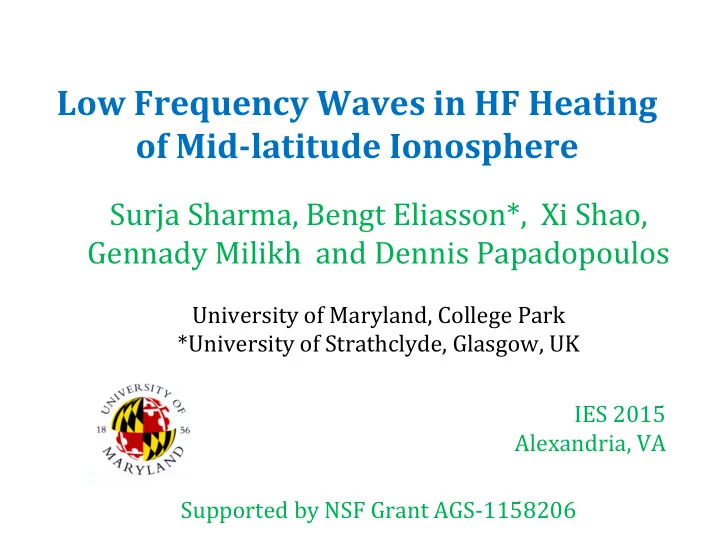

Low Frequency Waves in HF Heating of Mid-latitude Ionosphere Surja Sharma, Bengt Eliasson*, Xi Shao, Gennady Milikh and Dennis Papadopoulos University of Maryland, College Park *University of Strathclyde, Glasgow, UK IES 2015 Alexandria, VA Supported by NSF Grant AGS-1158206
HF Heating in the Ionosphere: Excitation of waves in D/E region Heating in the D/E region (~80 km) -Expts at Tromso, Sura ELF/ULF generated by variations in the auroral electrojet current Modified current flow due to local heating: Polar Electrojet (PEJ) antenna Fast cooling due to inelastic processes (vibrational and rotational) PEJ mechanism requires electrojet
HF Heating in the Ionosphere: Excitation of waves in F region Heating in the F region (~300 km) -Expts at HAARP Magnetosonic (MS) waves excited by diamagnetic current due to heating Shear Alfven (SA) waves generated by MS waves in the Hall layer Propagation of Alfven waves to the ground and the magnetosphere ELF waves generation without electrojet
ELF Waves in HF heating: High-latitude Ionosphere Physical mechanism Papadopoulos et al., GRL 2011
ELF Waves in HF heating: High-latitude Ionosphere DEMETER Observations of Shear Alfvén waves (2.5 Hz): HAARP expt Eliasson et al., JGR 2012
Simulation Model: Collisional Hall-MHD Collisional Hall-MHD model Faraday’s and Ampère’s laws Ion momentum equation Momentum equation for inertial-less electrons Electron pressure P e modulated by RF wave
Ionospheric profile and geometry
Simulation Setup • Source location L =1.6, Altitude = 300 km • Source dimension 40 x 80 km • ELF/ULF waves: 2, 10 Hz • Ionosphere conditions – Chapman density profile – Dipole magnetic field • Free space below 90 km: Continuity of E par and B n • Conducting ground: no E par and B n
Low Frequency Waves • Dispersion relation ω << ω ce , ω << ck || • R-Mode/whistler (-) and L-Mode/EMIC (+) waves • Whistler/helicon mode Obliquely propagating Alfvén waves: EMIC + Whistlers/MS Magnetosonic (MS) waves: , for
Simulation Results: 2Hz (Movie)
Simulation Results 10Hz (Movie)
Main features • Magnetosonic waves are created by HF heating and propagate at large angles to magnetic field lines. • Whistlers (R-mode) and EMIC (L-mode) waves propagate mainly along magnetic field lines • Direct generation of EMIC waves at the source region • Generation of EMIC and whistlers via mode conversion of MS waves in the E-region. • 10Hz: EMIC wavelength and propagation speed significantly smaller than for Whistlers.
f = 2 Hz F =2 Hz MS Alfven
f = 10 Hz f = 10 Hz MS Conversion MS -> Whistler +EMIC EMIC Whistler + EMIC
ELF waves for different modulation frequencies 2 Hz 10 Hz
EMIC Waves and Whistlers (10 Hz )
Whistler / EMIC features • Magnetosonic waves (shown by Bx) are created by HF heating and propagate upwards to the magnetosphere and downwards to E-region, where they convert to whistlers and EMIC waves. • EMIC waves also generated at the source region • EMIC and Whistler waves (shown by By and Bx) propagate along magnetic field lines • 10 Hz: EMIC waves cannot propagate beyond ion cyclotron resonance layer where their wavelength goes to zero • EMIC relatively short wavelength compared to whistlers
Summary • Generation of ELF waves by HF heating in the F region - in the absence of an electrojet • Realisitic ionospheric profile, collisionality and dipole magnetic field geometry • Direct generation of EMIC waves in source region, mode conversion of MS waves via Hall currents in the E-region • Provides features for comparison with satellite data during passes over the heating site. • Low frequency waves (plasma eigenmodes) in HF heating with no modulation
• References: • B. Eliasson, C.-L. Chang, and K. Papadopoulos (2012), Generation of ELF and ULF electromagnetic waves by modulated heating of the ionospheric F2 region, J. Geophys. Res., 117, doi:10.1029/2012JA017935 • Papadopoulos, K., N. A. Gumerov, X. Shao, I. Doxas, and C. L. Chang • (2011), HF-driven currents in the polar ionosphere, Geophys. Res. Lett., • 38, L12103, doi:10.1029/2011GL047368. • Papadopoulos, K., C.-L. Chang, J. Labenski, and T. Wallace (2011), First • demonstration of HF-driven ionospheric currents, Geophys. Res. Lett., 38, • L20107, doi:10.1029/2011GL049263.
f = 5 Hz MS Alfven Whistler
Motivation and observation • Ionospheric ULF Wave Generation without Electrojet [Papadopoulos et al., 2011a,b; Eliasson, Chang and Papadopoulos, 2012] – Both simulation and experiments – Up to 50 Hz – Ionospheric current drive (ICD) in F layer – Predictable and repeatable signal generation on daily basis – Viable technique in low latitude regions with robust F • ICD-driven ULF Wave generation and injection in EIW and the radiation belt – A comprehensive simulation model is needed • Inducing energetic particle precipitation from radiation belt through resonant pitch angle scattering – Pitch angle scattering protons with Alfven waves [Shao et al., 2009] – EMIC waves interact resonantly with relatvisitc electrons
Recommend
More recommend